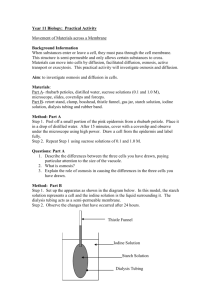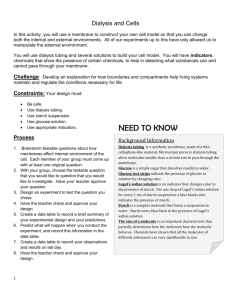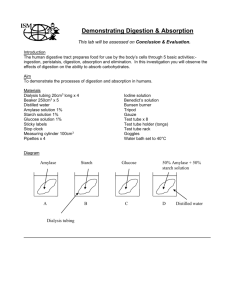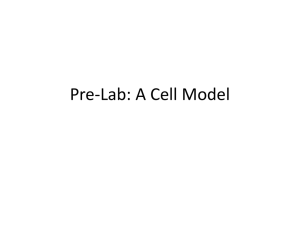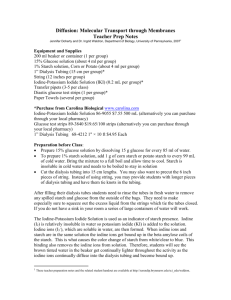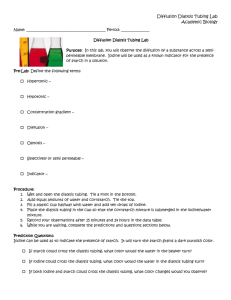Osmosis and Dialysis
advertisement
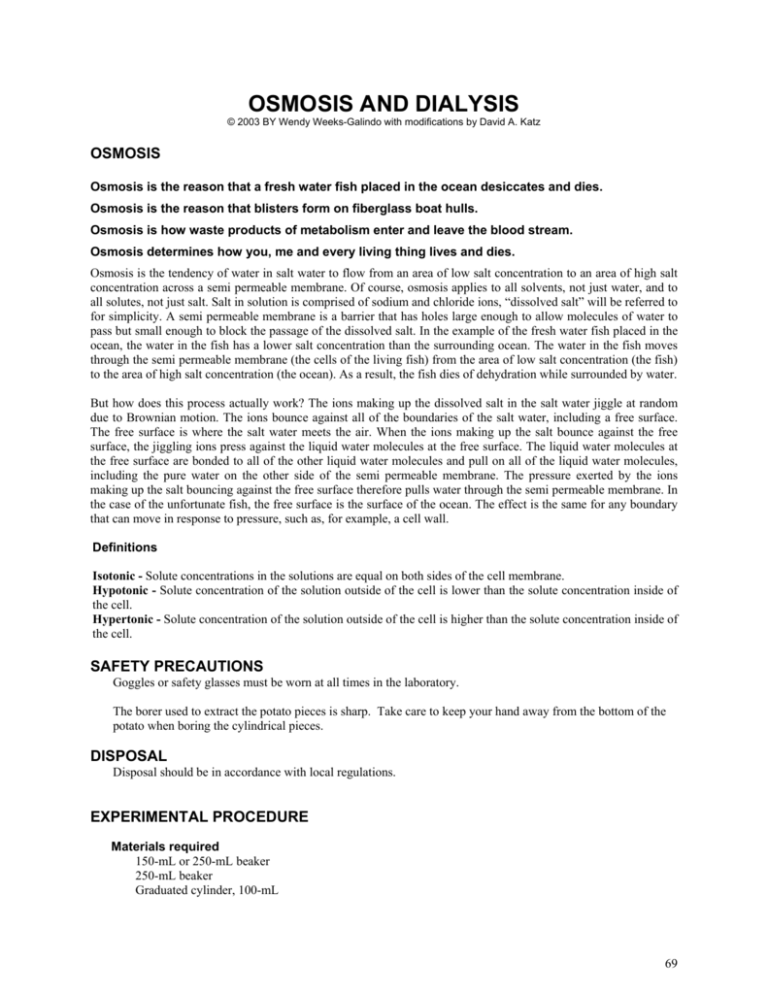
OSMOSIS AND DIALYSIS © 2003 BY Wendy Weeks-Galindo with modifications by David A. Katz OSMOSIS Osmosis is the reason that a fresh water fish placed in the ocean desiccates and dies. Osmosis is the reason that blisters form on fiberglass boat hulls. Osmosis is how waste products of metabolism enter and leave the blood stream. Osmosis determines how you, me and every living thing lives and dies. Osmosis is the tendency of water in salt water to flow from an area of low salt concentration to an area of high salt concentration across a semi permeable membrane. Of course, osmosis applies to all solvents, not just water, and to all solutes, not just salt. Salt in solution is comprised of sodium and chloride ions, “dissolved salt” will be referred to for simplicity. A semi permeable membrane is a barrier that has holes large enough to allow molecules of water to pass but small enough to block the passage of the dissolved salt. In the example of the fresh water fish placed in the ocean, the water in the fish has a lower salt concentration than the surrounding ocean. The water in the fish moves through the semi permeable membrane (the cells of the living fish) from the area of low salt concentration (the fish) to the area of high salt concentration (the ocean). As a result, the fish dies of dehydration while surrounded by water. But how does this process actually work? The ions making up the dissolved salt in the salt water jiggle at random due to Brownian motion. The ions bounce against all of the boundaries of the salt water, including a free surface. The free surface is where the salt water meets the air. When the ions making up the salt bounce against the free surface, the jiggling ions press against the liquid water molecules at the free surface. The liquid water molecules at the free surface are bonded to all of the other liquid water molecules and pull on all of the liquid water molecules, including the pure water on the other side of the semi permeable membrane. The pressure exerted by the ions making up the salt bouncing against the free surface therefore pulls water through the semi permeable membrane. In the case of the unfortunate fish, the free surface is the surface of the ocean. The effect is the same for any boundary that can move in response to pressure, such as, for example, a cell wall. Definitions Isotonic - Solute concentrations in the solutions are equal on both sides of the cell membrane. Hypotonic - Solute concentration of the solution outside of the cell is lower than the solute concentration inside of the cell. Hypertonic - Solute concentration of the solution outside of the cell is higher than the solute concentration inside of the cell. SAFETY PRECAUTIONS Goggles or safety glasses must be worn at all times in the laboratory. The borer used to extract the potato pieces is sharp. Take care to keep your hand away from the bottom of the potato when boring the cylindrical pieces. DISPOSAL Disposal should be in accordance with local regulations. EXPERIMENTAL PROCEDURE Materials required 150-mL or 250-mL beaker 250-mL beaker Graduated cylinder, 100-mL 69 Forceps or Crucible tongs sodium chloride potato cork borer Procedure In this experiment, pieces of potato will be placed into liquids of different concentrations, to show how water passes by osmosis into or out of plant tissue. The uptake or loss of water will be monitored by measuring changes in mass. 1. Make 100mL of the NaCl solution you were assigned by your instructor. 2. Using a borer, remove three cylindrical pieces of potato. 3. Determine a method to identify the three pieces of potato. 4. Feel the texture of your potato cylinders and record the observations. 5. Weigh and record the mass of each, individual piece of potato. 6. Put the three pieces in a small beaker. 7. Add enough of the liquid to completely cover the potato cylinders. Let the potato cylinders soak for 30 minutes. (Now is a good time to start the Dialysis experiment.) 8. After thirty minutes, drain the liquid into the waste container and blot the potato pieces on a paper towel. DO NOT squeeze them dry. 9. Weigh and record the mass of each individual piece of potato. 10. Feel the texture of your potato slices and record the observations. 11. Calculate the start to end ratio of the mass of your potato cylinders Start : End Ratio = initial mass final mass 12. Calculate the mean value for your Start:End Ratios. 13. Record the mean value of your Start:End ratio into the data table on the board so others may obtain your data and you can obtain the complementary results from the other groups in the class. Mass of potato cylinder for Your Solution (including concentration) __________________ Initial Mass Final Mass Start:End Ratio Slice #1 Slice #2 Slice #3 Mean Value of Start:End Ratio_______________ 70 Group Data Table Solution and Molarity DI Water Tap Water 0.05 M NaCl 0.1 M NaCI 0.15 M NaCl 0.20 M NaCl 0.25 M NaCl 0.30 M NaCI Mean value of start:end ratio Questions 1. What was the texture and your observations of your potato cylinders prior to placing them in the solution? 2. What was the texture and your observations of your potato cylinders after they were removed from the solution? . 3. Why take all this trouble with thin cylinders of potato? Surely a 20 g chunk would suffice. . 4. Why are we calculating a Start: End Ratio? Surely the differences between the initial and final masses are good enough. 5. Why use three pieces of potato? Isn’t one piece enough? 6. What would a Start:End ratio of 1.00 indicate? 71 7. What would a Start:End ratio greater than 1.00 indicate? 8. If a potato cylinder has lost 0.5 g in mass, what volume of water has gone from it? 9. Which of the solutions (using the class data) were isotonic? Hypotonic? Hypertonic? 10. Would this experiment work with other plant cells, and why? 11. Would this experiment work with animal cells, and why? 12. Would this experiment work with varying concentrations of other solutions, such as sugar, for example, and why? 13. What do these results show about the concentration of the cytoplasm in the potato cells at the start of the experiment? 72 Dialysis Dialysis is the reason we can remove toxic, metabolic waste molecules from a patient with diseased kidneys. Dialysis is the flow of certain solutes through a differentially permeable membrane, which has pores that are slightly larger than a semi permeable membrane. Remember, a semi permeable membrane is utilized in osmosis. Differentially permeable membranes allow the passage of small molecules but not larger molecules. In the example of removing toxins from diseased kidneys, small molecules such as urea and glucose are removed from a patient's blood but large molecules such as proteins and starch are not. During dialysis, arterial blood from the patient flows continuously through an instrument that contains a long coiled cellophane tube (dialysis tubing) that acts as a differentially permeable membrane. Surrounding this tube is a solution called the dialysate. The dialysate is an aqueous solution containing isotonic concentrations of all the components that are to remain in the blood, but none of the waste products. Thus, the concentration of waste products is higher in the blood than the dialysate. Therefore, waste products flow from the blood into the dialysate faster than they return and the isotonic solution flows into the arterial blood to maintain a proper solute concentration. SAFETY PRECAUTIONS Goggles or safety glasses must be worn at all times in the laboratory. Benedict’s solution is toxic by ingestion. In the event of skin contact, wash the affected area with water. Wash your hands after any direct contact and wash your hands at the conclusion of the laboratory period. Iodine reagent will leave yellow-orange stains on your hands that will not wash off. Take care in handling the solution. Iodine is poisonous by ingestion. Wash your hands after any direct contact and wash your hands at the conclusion of the laboratory period. Any stains that do not wash off your hands will not be harmful to you. DISPOSAL Disposal should be in accordance with local regulations. EXPERIMENTAL PROCEDURE Materials required 250-mL beaker 12 test tubes dialysis tubing string 1.0% starch solution 10% glucose solution 5% sodium chloride solution Benedict’s reagent Iodine reagent 0.1 M silver nitrate solution in a dropper bottle Procedure In this experiment, starch, glucose, and sodium chloride (salt) solutions are placed in dialysis tubing, then the dialysis tubing is placed in distilled water (dialysate). The solution inside the tubing and the dialysate will be tested with Benedict's reagent, iodine reagent, and silver nitrate solution in order to determine which components have diffused through the differentially permeable membrane and which have not. 73 1. Obtain a 200 mm piece of dialysis tubing. Place it in a beaker of distilled or deionized water and allow it to soak for several minutes. 2. Obtain a clean 20 x 150 mm test tube and fill it half full with distilled water. 3. Remove the 200 mm piece of dialysis tubing from the beaker of water and tie a tight knot at one end, so the tubing will hold liquid, and open the other end. 4. Using a 1.0% starch solution fill the opened tubing a little less than half way. Using a 10% glucose solution, fill the dialysis tubing to within 35 mm of it's top. Using a 5% sodium chloride solution, fill the remainder of the dialysis tubing to within 25 mm of it's top. 5. Twist the top of the dialysis tubing closed and tie it with a piece of string. 6. Use distilled water to rinse any spilled solution from the outside of the tubing. 7. Place the tubing, knotted end first, in the large test tube containing distilled water. 8. Let the dialysis tubing remain undisturbed for a minimum of twenty minutes. Observation of solutions for testing for the presence of glucose, starch, and chloride. Benedicts Test 1. Using four test tubes, add eight drops of distilled water to test tube A, eight drops of glucose solution to test tube B, eight drops of starch solution to test tube C and eight drops of 5% sodium chloride solution to test tube D. To each of these test tubes add four drops of Benedict's reagent and mix the solution. 2. Record the initial color of the solution in each of these test tubes. 3. Place all four tubes in a hot-water (boiling) bath for three minutes. 4. Record the final color of the solution in each of these test tubes. 5. Keep these solutions in order to compare these results with your experiment results. Iodine Test 1. Using four test tubes, add eight drops of distilled water to test tube 1, eight drops of glucose solution to test tube 2, eight drops of starch solution to test tube 3 and eight drops of 5% sodium chloride solution to test tube 4. To each of these test tubes add four drops of iodine reagent and mix the solution. 2. Record the color of the solution in each of these test tubes. 3. Keep these solutions in order to compare these results with your experiment results. Chloride Test 1. Using four test tubes, add eight drops of distilled water to test tube A-1, eight drops of glucose solution to test tube A-2, eight drops of starch solution to test tube A-3 and eight drops of 5% sodium chloride solution to test tube A-4. To each of these test tubes add one or two drops of 0.1 M AgNO3 . 2. Record your observations of the solution in each of these test tubes. 3. Discard the solutions in the proper waste containers and clean the test tubes. Rinse the tubes with distilled water. Testing your dialysis experiment for the presence of glucose, starch, and chloride. After the dialysis tubing has soaked in water for a minimum of twenty minutes. 1. Test your dialysate with Benedicts reagent, as you did in the Benedict’s test, above. 74 2. Test the solution inside your dialysis tubing with Benedicts reagent, as you did in the Benedict’s test, above. 3. Compare both of these to your test tubes labeled A, B, and C. 4. Test your dialysate with iodine reagent, as you did in the iodine test, above. 5. Test the solution inside your dialysis tubing with iodine reagent, as you did in the iodine test, above. 6. Compare both of these to your test tubes labeled 1, 2, and 3. 7. Test your dialysate with 0.1 M AgNO3 solution, as you did in the chloride test, above. 8. Test the solution inside your dialysis tubing with 0.1 M AgNO3 solution, as you did in the chloride test, above. Clean Up At the conclusion of the experiment, clean all apparatus and glassware with soapy warer. Rinse with distilled or deionized water before putting glassware away. 75 Presence/Absence of glucose, starch, and chloride testing Test Initial Color Color after heating Glucose present? Yes/No Starch present? Yes/No Chloride present? Yes/No Benedicts test with: Distilled Water Glucose solution Starch solution Sodium chloride solution Dialysate Inside dialysis tubing Iodine with: Distilled Water XXX Glucose XXX Starch XXX Sodium chloride solution XXX Dialysate XXX Inside dialysis tubing XXX 0.1 M AgNO3 with: Distilled Water XXX Glucose XXX Starch XXX Sodium chloride solution XXX Dialysate XXX Inside dialysis tubing XXX 76 Questions 1. What is the purpose of the Benedict’s test? Iodine test? 0.1 M AgNO3 test? 2. What molecules diffused through the dialysis tubing? 3. What molecules remained inside the dialysis tubing? 4. Of the molecules that diffused through the dialysis tubing, did all the molecules diffuse out? Why or why not? 5. Did water diffuse out of the dialysis tubing? Why or why not? 6. What type of membrane does the dialysis tubing represent? 7. Give an example of this type of membrane that could be found in your body. 8. What are some other examples where dialysis is important? 1
